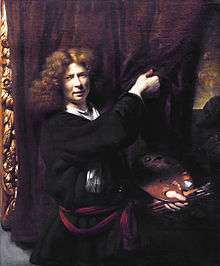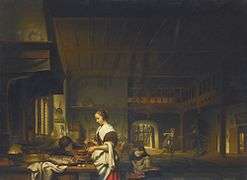Cornelis Bisschop
Cornelis Bisschop (12 February 1630 – 21 January 1674), was a Dutch Golden Age painter.
Cornelis Bisschop | |
|---|---|
 Self-portrait | |
| Born | Cornelis Bisschop 12 February 1630 |
| Died | 21 January 1674 (aged 43) |
| Nationality | Netherlands |
| Known for | Painting |
| Movement | Baroque |
Biography
In ca. 1650 he was a student of Ferdinand Bol in Amsterdam.[1] In 1653 he was back in Dordrecht, where he got married. According to Houbraken he was the first to paint carved trompe l'oeil wooden panels in such an ingenious way that they became quite popular.[2] He painted historical allegories, portraits, still lifes, and genre-works. He was asked to paint for the Danish court, but he died unexpectedly, leaving his wife and eleven children.[3]
Of these children, two sons Abraham and Jacobus and three daughters became painters. These had been his students along with Margaretha van Godewijk who wrote an emblem about his self-portrait with a curtain, which illustrates the legend of Zeuxis.[2]
- Cornelis Bisschop
 Kitchen interior with a woman cooking and a boy blowing flames
Kitchen interior with a woman cooking and a boy blowing flames Girl peeling an apple 1667
Girl peeling an apple 1667.jpg) A Young Woman and a Cavalier
A Young Woman and a Cavalier_met_een_portret_van_Cornelis_de_Witt_-_Allegory_on_the_Raid_on_the_Medway_(Cornelis_Bisschop%2C_1668).jpg) Allegory on the Raid on the Medway
Allegory on the Raid on the Medway
References
- Cornelis Bisschop in RKD
- (in Dutch) Kornelis Bisschop biography in De groote schouburgh der Nederlantsche konstschilders en schilderessen (1718) by Arnold Houbraken, courtesy of the Digital library for Dutch literature
- Libby, Alexandra. "Cornelis Bisschop". he Leiden Collection Catalogue. Arthur K. Wheelock Jr. Retrieved 21 April 2017.
External links
| Wikimedia Commons has media related to Cornelis Bisschop. |